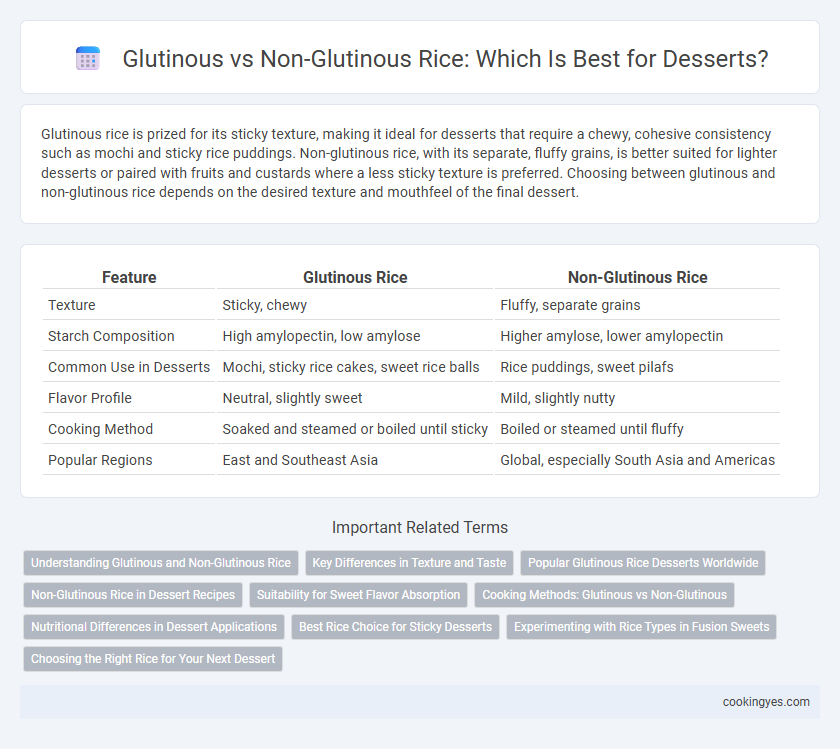Glutinous rice is prized for its sticky texture, making it ideal for desserts that require a chewy, cohesive consistency such as mochi and sticky rice puddings. Non-glutinous rice, with its separate, fluffy grains, is better suited for lighter desserts or paired with fruits and custards where a less sticky texture is preferred. Choosing between glutinous and non-glutinous rice depends on the desired texture and mouthfeel of the final dessert.
Table of Comparison
| Feature | Glutinous Rice | Non-Glutinous Rice |
|---|---|---|
| Texture | Sticky, chewy | Fluffy, separate grains |
| Starch Composition | High amylopectin, low amylose | Higher amylose, lower amylopectin |
| Common Use in Desserts | Mochi, sticky rice cakes, sweet rice balls | Rice puddings, sweet pilafs |
| Flavor Profile | Neutral, slightly sweet | Mild, slightly nutty |
| Cooking Method | Soaked and steamed or boiled until sticky | Boiled or steamed until fluffy |
| Popular Regions | East and Southeast Asia | Global, especially South Asia and Americas |
Understanding Glutinous and Non-Glutinous Rice
Glutinous rice, also known as sticky rice, contains high levels of amylopectin, making it ideal for desserts that require a chewy, sticky texture, such as mochi and mango sticky rice. Non-glutinous rice has lower amylopectin and higher amylose content, resulting in a fluffier and less sticky consistency, perfect for desserts that need lightness, like rice pudding. Understanding the starch composition in both rice types is crucial for selecting the right rice to achieve the desired texture in sweet recipes.
Key Differences in Texture and Taste
Glutinous rice, also known as sticky rice, has a high amylopectin content that gives desserts a chewy, sticky texture and a slightly sweet, rich flavor. Non-glutinous rice contains more amylose, resulting in a drier, fluffier texture with a more neutral taste that absorbs flavors well but lacks the inherent sweetness of glutinous varieties. These key differences influence the choice of rice in traditional desserts, where glutinous rice is preferred for its sticky consistency and distinct mouthfeel.
Popular Glutinous Rice Desserts Worldwide
Glutinous rice, also known as sticky rice, is the preferred choice for many popular desserts worldwide due to its chewy texture and sweetness retention. Iconic dishes such as Thai mango sticky rice, Filipino bibingka, and Japanese mochi showcase the versatility of glutinous rice in creating rich, traditional sweets. Non-glutinous rice, often used in puddings like rice pudding or kheer, lacks the sticky consistency, resulting in a creamier texture rather than the characteristic chewiness of glutinous rice desserts.
Non-Glutinous Rice in Dessert Recipes
Non-glutinous rice, also known as regular or long-grain rice, is favored in dessert recipes that require a light and fluffy texture, such as rice puddings and fruit rice salads. Its lower amylopectin content prevents stickiness, creating a grain separation ideal for dishes where texture clarity is essential. Popular varieties like Jasmine and Basmati enhance desserts with their aromatic qualities while maintaining a firm bite.
Suitability for Sweet Flavor Absorption
Glutinous rice has a sticky, chewy texture that excels at absorbing sweet flavors, making it ideal for desserts like mochi and sticky rice pudding. Non-glutinous rice retains a fluffier, separate grain structure, less effective for capturing syrups and sweet sauces but preferred in lighter, less dense desserts. The high amylopectin content in glutinous rice enhances its syrup absorption, while non-glutinous varieties contain more amylose, resulting in less stickiness and reduced sweetness retention.
Cooking Methods: Glutinous vs Non-Glutinous
Glutinous rice requires soaking for several hours before steaming to achieve its characteristic sticky texture, ideal for desserts like mochi and sticky rice cakes. Non-glutinous rice is typically boiled or steamed without soaking, resulting in a fluffy and separate grain structure suitable for lighter desserts such as rice puddings. Proper cooking methods enhance the inherent texture differences, making glutinous rice chewy and non-glutinous rice soft and airy in dessert applications.
Nutritional Differences in Dessert Applications
Glutinous rice contains higher amylopectin starch, resulting in a sticky texture ideal for chewy desserts but offers lower fiber and protein compared to non-glutinous rice. Non-glutinous rice, rich in amylose, provides a firmer texture and generally has higher nutritional content, including more fiber and antioxidants, which contribute to better digestion and health benefits. Choosing between glutinous and non-glutinous rice impacts not only dessert texture but also the nutritional profile tailored to specific dietary needs.
Best Rice Choice for Sticky Desserts
Glutinous rice, also known as sticky rice, is the best choice for desserts requiring a chewy, sticky texture due to its high amylopectin content which enhances adhesion and moisture retention. Non-glutinous rice, with a higher amylose content, produces a firmer and less sticky grain, making it unsuitable for traditional sticky desserts like mochi or mango sticky rice. Choosing glutinous rice ensures an ideal consistency and authentic flavor profile essential for classic Asian and Southeast Asian sticky rice desserts.
Experimenting with Rice Types in Fusion Sweets
Experimenting with glutinous and non-glutinous rice in fusion desserts unlocks diverse textures and flavors, enhancing sweet treats with unique chewiness or fluffiness. Glutinous rice, known for its sticky and gelatinous consistency, complements mochi and sticky rice puddings, while non-glutinous rice offers a lighter, grainier texture perfect for rice-based tarts or custards. Combining these rice types in desserts creates innovative fusion sweets that balance traditional Asian characteristics with contemporary culinary trends.
Choosing the Right Rice for Your Next Dessert
Glutinous rice, also known as sticky rice, has a high amylopectin content that provides the chewy texture essential for many Asian desserts like mochi and mango sticky rice. Non-glutinous rice varieties, such as jasmine or basmati, contain more amylose, resulting in a fluffier and less sticky consistency, making them better suited for lighter, grainier desserts like rice puddings. Selecting the right rice depends on the desired texture and dessert style, with glutinous rice offering elasticity and non-glutinous rice providing a delicate mouthfeel.
Glutinous vs Non-glutinous for Desserts Infographic

 cookingyes.com
cookingyes.com